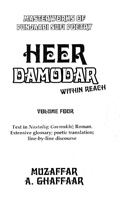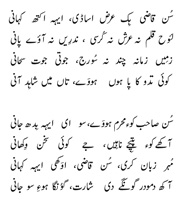A definite version
Muzaffar Ghaffar's complete and comprehensive translation is a labour of love
By Nadir Ali
Heer Damodar (boxed four
volumes)
By Muzaffar Ghaffar
Publisher: Ferozsons (Pvt) Ltd.
Price: Rs 3999
Pages: 1754
Among the epoch making series of Muzaffar Ghaffar on classic works of Punjabi poetry, this four volume work is truly a milestone. As stated in my earlier reviews, there is no other example of a more comprehensive attempt covering the entire classical poetical work of a major language anywhere in the world. Punjabi poetry classics are substantial in volume and depth. Fifteen odd years of gruelling hard work, which would be about twenty five volumes soon, proves the perspiration of heroic proportions. But there is inspiration galore in the translation in English verse and in the detailed commentary. Organisation and methodical work is of essence in works of such monumental nature. "Craft is the essence of art," Anthony Burgess said and craft is a product of exercise and practice. Although Najm Hosain Syed, Ghaffars's mentor and teacher in this project, has written one of the best books in Punjabi criticism or literary criticism anywhere in the world -- Akath Kahani a commentary on Heer Damoder, unread even among the academia and the elite of Punjabi reading people.
Ghaffar has put Heer Damodar on record for the whole English reading world. The classic, because of its inexplicable obscurity over a long time has remained largely free of admixture and abuse that every major classic work of popular lot has suffered in Punjabi. It is a gem among the Punjabi classics. Like all Punjabi poetic tales it was written to be performed. It is a screenplay ready to be filmed or staged. Like olden times, old man Damodar will be there too, playing a narrator, while the characters play their parts and action takes place. He says "I was there while it happened" A device used by Peloo in Mirza Sahiban, in another fashion and by many others. Heer Waris Shah too is a play interrupted by lengthy narrated commentaries. There are many other examples including modern day verse play by Shiv Kumar Batalvi. Damodar was an early seventeenth century poet. Shiv Kumar Batalvi, a twentieth century poet considered the only major Hindu poet in Punjabi, unless you count numerous Gurus, before the establishment of the Sikh Punth. Hindus perhaps had enough religious epics to occupy the stage like Ram Lila etc.
To say Damodar is almost at par with Waris Shah is like committing blasphemy. But it is a moot question and a comparative study will not only enhance our understanding of Waris Shah but the history of Heer writing and Punjabi poetry. They belong to different species of style in literature. Waris presumes the audience knows the story line. He uses poetic devices and lengthy statements of political and social nature to dramatise and explicate. Damodar uses nuance and undertones to make his statement. The dialogue is strictly contextual. Waris uses loud and hard hitting repartee. His posture is confrontational and his irony is biting. Damodar uses the soft touch, but his irony can also be sharp and deadly.
Here is Muzaffar Ghaffar performing this pioneering task, opening new doors in the study of Punjabi poetry. Here is a previously obscure work of truly classical nature. The 906 stanzas that he has translated in pristine English verse consist of four lines each, there are over eighteen hundred twelve couplets or three thousand six hundred and twenty four lines. It is the entire epic as written by Damodar. No one has attempted that with any Punjabi epic in any language. Only a partial verse translation of Heer Waris Shah by late Abid Hussain in Urdu and an indifferent one by Ali Nasir Zaidi also exists in Urdu. We should not forget great RC Temple's Legends of Punjab. His work does not cater to accuracy. His sources were local troubadours, who were powerful folk singers with large repertoires of very inaccurate nature. Lok Virsa has left no records, books or archives. The tombstone of Punjabi Language should read "No archives"
The originals of Heer Damodar and Heer Waris Shah are also the most authentic. The former has the inputs of late Prof. Asaf Khan and Najm Hosain Syed, two veritable masters of Punjabi scholarship. The "Heer Waris Shah" version is based on lifetime work of Sheikh Abdul Aziz, another edition also of equally monumental nature by Sheikh Sharif Sabir, the two great "Sheikhs" of Punjabi literature, again seen over by Najm Hosain Syed. For the original full text alone, these books are invaluable. With verse translation and his commentary in detail, Ghaffar has rendered memorable service to Punjabi literature.
With falling standards of scholarship in Punjabi in both India and Pakistan, we will before long have to resort to the foreign universities, who despite better standards, have only an archaeological interest in Punjabi literature and mainly access the language through English translation. If the prayed for renaissance ever occurs in Punjabi, Muzaffar Ghaffar would play a major part in reintroducing the English reading scholars of Punjabi to the classics of Punjabi literature.
But the response so far to these publications has been lukewarm. Creative work may be its own reward, but this work besides being creative is instructive ground work for others to return to Punjabi, whose treasure of classic poetry compares with the best in any language. But this is not the stuff of bestsellers. It is the kind of work that grows over the enquiring mind. People need to explore and pore over this work. The pleasures promised to lovers of Punjabi literature are unlimited.
Damodar is a very subtle poet, whose secrets lie not only between the lines but in the undertones and nuances of each word, metaphor and image. Here are two for flavour from the climax of the book; the trial of Heer and Ranjha after elopement from Heer's forced marriage.
Heer says :
" Listen to our petition Judge, unutterable this
tale to recite.
Stone Tablets , Empyrean Throne, no Canopy, no
water in sight
Space ,Time , moon nor sun, light in a body of light
If anyone was from then a witness I'd invite"
Ranjha says:
"Listen Lord if there was an intimate will know
this rite only he
If some speak, no one believes, if someone
expound fully
If tongue is sealed, listen Judge, difficult this story
Speak Damodar to know a mute's signs, only a
mute's ability."
For ages to come when you need the original and corrected version of Damodar you need an English translation in verse, and its different interpretations of these verses; Muzaffar Ghaffar would be the capital source. But for being a work of translation, please do not underestimate Muzaffar's poetry. He is not only accurate and meticulous in translation; there is a remarkable discipline in the meter / rhythm.
Though stated in the previous reviews, I have my ideological reservations in explaining the essence of Heer. Where I think class and property are the real obstacles that beset the lovers. Muzaffar leans more towards the mystical and spiritual side. In essence, that too, is an explication of the sociological framework, In any case the reader is provided ample opportunity by Muzaffar Ghaffar's open ended commentary, to reach his own conclusions.